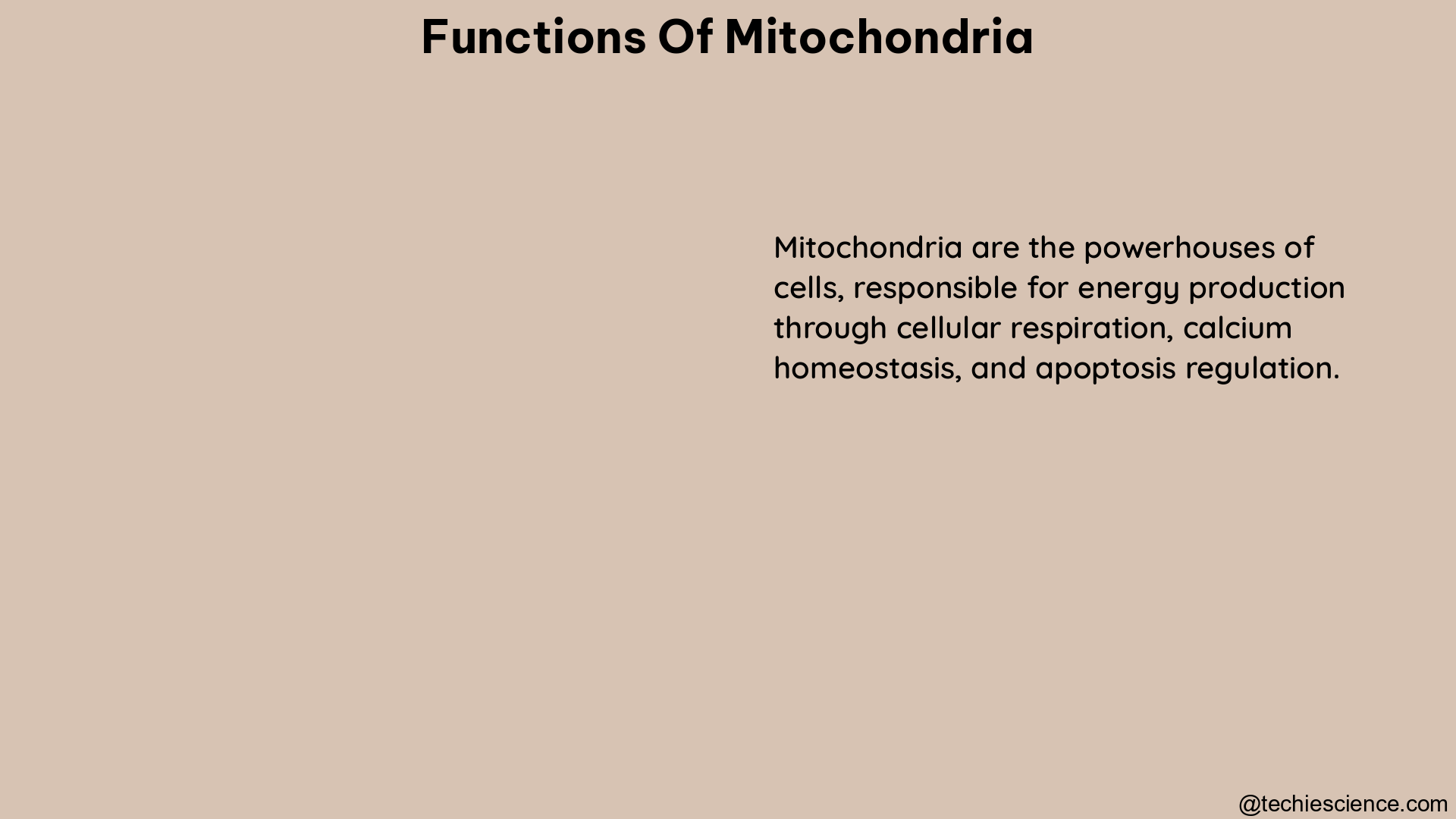Mitochondria are the powerhouses of eukaryotic cells, responsible for the production of the majority of cellular energy in the form of adenosine triphosphate (ATP) through the process of oxidative phosphorylation. However, their functions extend far beyond energy production, encompassing crucial roles in metabolism, calcium homeostasis, and cell signaling. This comprehensive guide delves into the measurable and quantifiable data that shed light on the diverse functions of these dynamic organelles.
Mitochondrial Mass and Biogenesis
Mitochondrial mass is a crucial indicator of the cell’s energy demands and the overall health of the mitochondrial network. This parameter can be measured using various techniques, such as flow cytometry, western blotting, and quantitative PCR to quantify mitochondrial DNA (mtDNA) content.
-
Flow Cytometry: This method allows for the rapid and accurate quantification of mitochondrial mass by staining cells with fluorescent dyes, such as MitoTracker Green, that specifically label mitochondria. The mean fluorescence intensity (MFI) can be used to determine the relative mitochondrial content in different cell types or under various experimental conditions.
-
Western Blotting: Mitochondrial proteins, such as the subunits of the electron transport chain complexes or the mitochondrial import machinery, can be quantified using western blotting techniques. This approach provides a more direct measure of mitochondrial mass by assessing the abundance of specific mitochondrial markers.
-
Quantitative PCR: The copy number of mtDNA can be determined using quantitative PCR (qPCR) assays that target unique mitochondrial gene sequences. This method is particularly useful for evaluating changes in mitochondrial biogenesis, as the mtDNA content is directly proportional to the number of mitochondria within the cell.
For example, a study published in Scientific Reports used a mass spectrometry-based approach to quantitatively evaluate sample-specific percent mitochondrial enrichment in various mouse tissues, providing valuable insights into the tissue-specific differences in mitochondrial content.
Mitochondrial Membrane Potential

The mitochondrial membrane potential (ΔΨm) is a crucial parameter that reflects the electrochemical gradient across the inner mitochondrial membrane, which is essential for ATP synthesis and other mitochondrial functions. This parameter can be measured using fluorescent dyes, such as tetramethylrhodamine, methyl ester (TMRM) or JC-1, that accumulate in mitochondria in a membrane potential-dependent manner.
-
TMRM: This cationic dye accumulates in the mitochondrial matrix in proportion to the membrane potential, allowing for the quantification of ΔΨm. A study published in the Journal of Biological Chemistry used TMRM to measure ΔΨm in rat liver mitochondria, providing insights into the role of mitochondrial calcium handling in oxidative damage.
-
JC-1: This dye exhibits potential-dependent accumulation in mitochondria, where it forms red fluorescent aggregates at high membrane potentials and green fluorescent monomers at low membrane potentials. The ratio of red to green fluorescence can be used to assess changes in ΔΨm.
Maintaining a proper mitochondrial membrane potential is crucial for various mitochondrial functions, including ATP production, calcium homeostasis, and the regulation of apoptosis. Disruptions in ΔΨm have been associated with numerous pathological conditions, making it an important biomarker for mitochondrial health.
Mitochondrial Respiration and Oxidative Phosphorylation
Mitochondrial respiration, the process of oxygen consumption and ATP production through the electron transport chain (ETC) and oxidative phosphorylation (OXPHOS), is a fundamental function of these organelles. Mitochondrial respiration can be measured using techniques such as high-resolution respirometry or oxygen consumption rate (OCR) measurements.
-
High-Resolution Respirometry: This method allows for the precise measurement of oxygen consumption by isolated mitochondria or intact cells, providing insights into the activity of the ETC and the efficiency of OXPHOS. Parameters such as basal respiration, ATP-linked respiration, and maximal respiratory capacity can be quantified.
-
Oxygen Consumption Rate (OCR): The OCR can be measured using specialized equipment, such as the Seahorse XF Analyzer, which monitors the real-time changes in oxygen levels in the extracellular environment. This approach enables the assessment of mitochondrial function in live cells, including the capacity for ATP production, proton leak, and respiratory reserve.
For example, a study published in the International Journal of Molecular Sciences used a quantitative histochemical technique to measure the activity of succinate dehydrogenase (SDH), a key enzyme located in the inner mitochondrial membrane that participates in both the tricarboxylic acid (TCA) cycle and the ETC as Complex II. This provided valuable insights into the regulation of mitochondrial respiration and energy metabolism.
Mitochondrial Reactive Oxygen Species (ROS) Production
Mitochondria are a major source of cellular reactive oxygen species (ROS), which can have both beneficial and detrimental effects on cellular function. Mitochondrial ROS production can be measured using fluorescent dyes, such as dichlorofluorescein (DCF) or dihydroethidium (DHE).
-
DCF: This dye is oxidized by various ROS, including hydrogen peroxide (H2O2), peroxynitrite, and hydroxyl radicals, resulting in the emission of green fluorescence. DCF has been used to measure mitochondrial ROS production in isolated mitochondria, as demonstrated in a study published in the Journal of Biological Chemistry.
-
Dihydroethidium (DHE): This dye is oxidized by superoxide anions (O2•-) to form a red fluorescent product, 2-hydroxyethidium. DHE can be used to specifically detect mitochondrial superoxide production, providing insights into the redox state of the mitochondria.
Maintaining a balance between mitochondrial ROS production and antioxidant defenses is crucial for cellular homeostasis. Dysregulation of mitochondrial ROS has been implicated in various pathological conditions, making it an important parameter to monitor in the context of mitochondrial function.
Mitochondrial Calcium Handling
Mitochondria play a crucial role in the regulation of cellular calcium (Ca2+) homeostasis, as they can rapidly accumulate and release Ca2+ in response to changes in the cytosolic Ca2+ concentration. Mitochondrial calcium handling can be measured using fluorescent dyes, such as Fura-2 or Rhod-2.
-
Fura-2: This ratiometric dye exhibits a shift in its excitation spectrum upon binding to Ca2+, allowing for the quantification of mitochondrial Ca2+ uptake and release. A study published in the Journal of Biological Chemistry used Fura-2 to measure calcium uptake in rat liver mitochondria, providing insights into the role of mitochondrial calcium handling in oxidative damage.
-
Rhod-2: This dye is a Ca2+-sensitive fluorescent indicator that preferentially accumulates in the mitochondrial matrix, enabling the direct measurement of mitochondrial Ca2+ levels. Rhod-2 has been used to study the dynamics of mitochondrial Ca2+ handling in various cell types and experimental models.
Mitochondrial calcium handling is essential for the regulation of numerous cellular processes, including energy metabolism, apoptosis, and cell signaling. Disruptions in mitochondrial calcium homeostasis have been linked to various pathological conditions, highlighting the importance of this parameter in the assessment of mitochondrial function.
Mitochondrial Dynamics
In addition to the quantifiable parameters discussed above, mitochondria are dynamic organelles that undergo constant fission and fusion, a process that is critical for maintaining mitochondrial health and function. Mitochondrial dynamics can be visualized and quantified using fluorescence microscopy techniques, such as time-lapse imaging or super-resolution microscopy.
-
Time-Lapse Imaging: By labeling mitochondria with fluorescent dyes or proteins, researchers can capture the real-time movements and morphological changes of mitochondria within living cells. This approach allows for the quantification of parameters like mitochondrial length, branching, and the frequency of fission and fusion events.
-
Super-Resolution Microscopy: Advanced imaging techniques, such as stimulated emission depletion (STED) or structured illumination microscopy (SIM), can provide high-resolution, nanoscale visualization of mitochondrial dynamics. A study published in the Journal of Cell Biology used super-resolution microscopy to visualize and quantify mitochondrial dynamics in live cells, revealing the intricate mechanisms underlying these processes.
Mitochondrial dynamics are closely linked to various cellular functions, including energy production, calcium homeostasis, and apoptosis. Disruptions in mitochondrial dynamics have been associated with numerous pathological conditions, making this an important area of study in the field of mitochondrial biology.
In conclusion, the functions of mitochondria can be measured and quantified using a variety of techniques, providing valuable insights into the role of these organelles in cellular homeostasis and disease pathogenesis. By understanding the measurable and quantifiable aspects of mitochondrial biology, researchers and clinicians can develop more targeted and effective strategies for the diagnosis, monitoring, and treatment of mitochondrial-related disorders.
References:
- McLaughlin, K.L., Hagen, J.T., Coalson, H.S. et al. Novel approach to quantify mitochondrial content and intrinsic bioenergetic efficiency across organs. Sci Rep 10, 17599 (2020). https://doi.org/10.1038/s41598-020-74718-1
- Porter, G.A., Jiang, L., Wang, X., & Brand, M.D. Mitochondrial calcium handling and oxidative damage in rat liver mitochondria. J Biol Chem 285, 36677–36688 (2010). https://doi.org/10.1074/jbc.M110.125226
- Li, X., Wang, Y., Li, Y., & Wang, Y. Cell-Based Measurement of Mitochondrial Function in Human Airway Smooth Muscle Cells. Int J Mol Sci 24, 11506 (2023). https://doi.org/10.3390/ijms241411506
- Friedman, J.R., Nunnari, J., & Lackner, L.L. Mitochondrial dynamics in health and disease. J Cell Biol 219, 337–350 (2018). https://doi.org/10.1083/jcb.201711140

Hi…I am Sadiqua Noor, done Postgraduation in Biotechnology, my area of interest is molecular biology and genetics, apart from these I have a keen interest in scientific article writing in simpler words so that the people from non-science backgrounds can also understand the beauty and gifts of science. I have 5 years of experience as a tutor.
Let’s connect through LinkedIn-